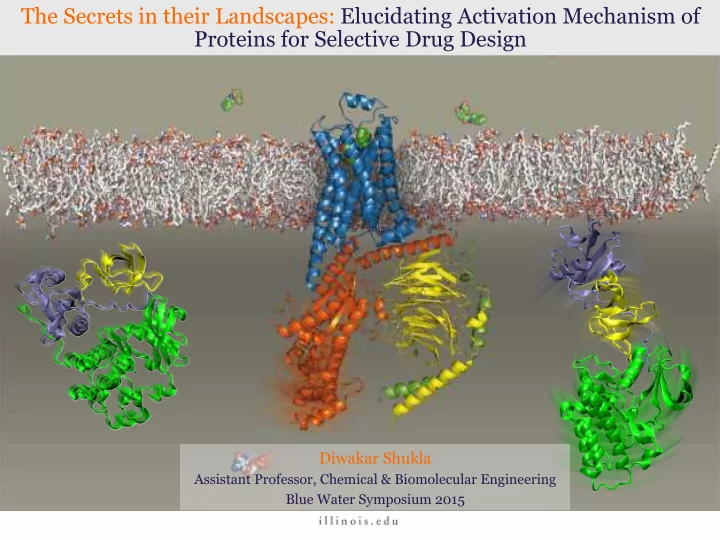

The Secrets in their Landscapes: Elucidating Activation Mechanism of Proteins for Selective Drug Design Diwakar Shukla Assistant Professor, Chemical & Biomolecular Engineering Blue Water Symposium 2015
Cellular Signaling and human diseases Cellular Signaling and human diseases Rosenbaum et. al., Nature, 2009. �
Cellular Signaling and diseases Cellular Signaling and diseases Other Receptors 8% Ion channels 7% Transporters 4% GPCRs 30% Others 4% Kinases 47% Zanoni et. al., FEBS letters, 583, 11, 2009
Challenge: Long time scale associated with conformational change Challenge: Long time scale associated with conformational change �
Markov State Models (MSM) Markov State Models (MSM) The most basic ingredients of Markov State Models are the states and rate constants connecting them. � A B • States and rates are familiar in the context of chemical equilibria � • Complex networks of states and transitions are possible � C � dP D � ∑ ∑ i k ji P j k ij P dt = − i j ≠ i j ≠ i i , j = A , B , C , D
Long timescale phenomena as series of Markov jump processes dP B ∑ ∑ i k ji P j k ij P dt = − A i j ≠ i j ≠ i i , j = [0,3000] How do we get rates ? � k AB nanoseconds � k AC 100’s of microseconds � C
Adaptive sampling of the conformational landscape � 2. Conformational sampling � 1. Select starting conformation � 3. Build Markov State Model � 4. Select new starting conformations �
Adaptive sampling of the conformational landscape � MSM Adaptive Sampling MSM Adaptive Sampling � Single MD Trajectory Single MD Trajectory �
G-Protein Coupled Receptors G-Protein Coupled Receptors � 2012 Nobel Prize in Chemistry 14 Angstroms Kobilka and coworkers, Nature, 2011. �
Kinetics of GPCR molecular switches Kinetics of GPCR molecular switches � Receptor without ligand Activating ligand bound Connector rmsd from active Connector rmsd from active Helix 5 bulge rmsd from active Helix 5 bulge rmsd from active Angstroms Angstroms NPxxY rmsd from active NPxxY rmsd from active Helix 3-Helix6 Distance Helix 3-Helix6 Distance μ s μ s
Intermediate states select for novel drug molecules Intermediate states select for novel drug molecules kcal/mol Carazolol Connector rmsd from inactive (Å) BI-167107 Connector rmsd from inactive (Å) active inactive H3-H6 distance (Å) H3-H6 distance (Å)
Conformational changes in Calmodulin Shukla et al., Nat. Commun., in review, 2015
Conformational changes in Calmodulin holo-CaM apo-CaM Shukla et al., Nat. Commun., In press, 2015
Intermediate states along the highest flux pathway Hydrophobic repacking of the core determines the substrate selectivity red: Phe, orange: hydrophobic, grey: other Shukla et al., Nat. Commun., In review, 2015
Prediction of chemically and sterically distinct binding interfaces red: Phe; orange: hydrophobic; cyan: Met; grey: other
Prediction of chemically and sterically distinct binding interfaces White dots represent the available CaM crystal structures in PDB. Simulations were started from only two structures of CaM. colorbar units: kcal/mol
Molecular Design of Drought resistant plants
Fine tuning plants at molecular level Motivation: Climate Change, Population Growth, Improved Agrochemicals, Links to Human Health
Steroid signaling and plant development 1 2 3
Simulation and experiments for obtaining mechanistic insights in growth signaling
Computational Plant Engineering on Blue Waters Molecule Cell System Ecosystem ABM FE ODE/PDE MM Model Types O’Dwyer: Ecosystem MM – Molecular Modeling Long: System ODE – Ordinary Diff. Eq. Marshall-Colon: Cell/Gene ABM – Agent Based Modeling Shukla: Molecule FE – Finite Element PDE – Partial Diff. Eq. Long et al., Cell, 2015
Acknowledgements Blue Waters Supercomputer Alexander S. Moffett Zahra Shamsi Prof. Vijay S. Pande, Stanford University
Recommend
More recommend